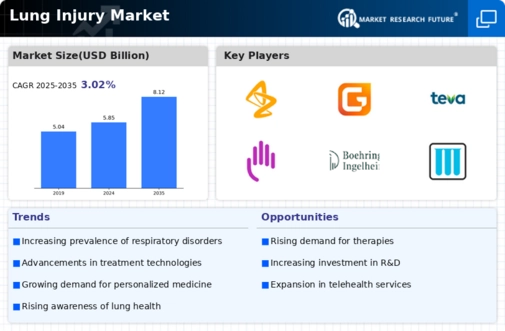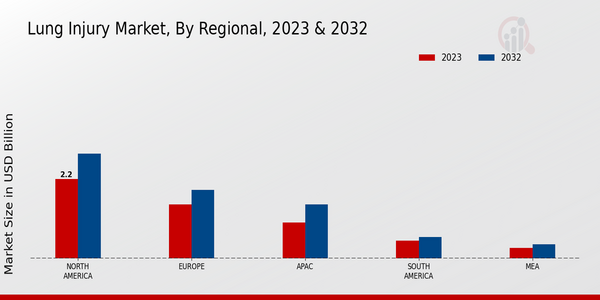Market Growth Projections
The Global Lung Injury Market Industry is projected to experience substantial growth over the coming years, with estimates indicating a market value of 5.85 USD Billion in 2024 and an anticipated increase to 8.12 USD Billion by 2035. This growth trajectory suggests a compound annual growth rate (CAGR) of 3.02% from 2025 to 2035. The market dynamics are influenced by various factors, including technological advancements, increased healthcare expenditure, and a growing awareness of lung health. These projections highlight the potential for innovation and investment in the lung injury sector, indicating a robust future for the industry.
Growing Awareness of Lung Health
Public awareness regarding lung health is steadily increasing, significantly impacting the Global Lung Injury Market Industry. Educational campaigns and advocacy efforts are emphasizing the importance of lung health and the risks associated with lung injuries. This heightened awareness is leading to more individuals seeking medical attention for respiratory issues, which in turn drives demand for lung injury treatments. As healthcare systems respond to this growing need, the market is expected to expand, reflecting the changing attitudes towards lung health. The proactive approach to lung health may also encourage preventive measures, further influencing market dynamics.
Increased Healthcare Expenditure
The Global Lung Injury Market Industry benefits from the rising healthcare expenditure observed across various regions. Governments and private sectors are allocating more resources to healthcare, which includes funding for lung injury research and treatment. This trend is particularly evident in developed nations, where healthcare budgets are expanding to accommodate advanced therapies and preventive measures. As a result, the market is poised for growth, with a compound annual growth rate (CAGR) of 3.02% anticipated from 2025 to 2035. Increased investment in healthcare infrastructure is likely to enhance access to lung injury treatments, thereby expanding the market.
Rising Incidence of Lung Injuries
The Global Lung Injury Market Industry experiences a notable increase in demand due to the rising incidence of lung injuries, which are often linked to environmental factors and occupational hazards. For instance, exposure to pollutants and toxic substances in various industries has led to a surge in respiratory ailments. This trend is reflected in the projected market value of 5.85 USD Billion in 2024, indicating a growing need for effective treatment options and preventive measures. As awareness of lung health increases, healthcare providers are likely to invest more in innovative therapies, further driving the market's expansion.
Advancements in Medical Technology
Technological advancements play a crucial role in shaping the Global Lung Injury Market Industry. Innovations in diagnostic tools and treatment modalities have improved the management of lung injuries. For example, the development of minimally invasive surgical techniques and advanced imaging technologies has enhanced patient outcomes. These advancements not only facilitate early detection but also promote more effective interventions. As a result, the market is expected to grow, with a projected value of 8.12 USD Billion by 2035. The continuous evolution of medical technology suggests that the industry will likely witness sustained growth as new solutions emerge.
Regulatory Support for Lung Injury Research
Regulatory bodies are increasingly supporting research initiatives focused on lung injuries, which is beneficial for the Global Lung Injury Market Industry. Funding programs and grants aimed at understanding the causes and treatments of lung injuries are being established. This support fosters innovation and encourages collaboration between researchers and healthcare providers. As a result, new therapies and treatment protocols are likely to emerge, enhancing patient care. The commitment to advancing lung injury research suggests a positive outlook for the market, as regulatory support can lead to breakthroughs that improve treatment efficacy and patient outcomes.













